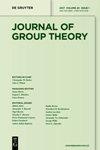双曲反射群中无穷远处的反射长度
IF 0.5
3区 数学
Q4 MATHEMATICS
引用次数: 0
摘要
在由𝑛维双曲空间中的超平面反射生成的离散群中,元素的反射长度是群中足以因数化该元素的超平面反射的最小数目。对于以这种方式产生的柯克赛特群,如果没有分裂成球面反射群和仿射反射群的直接乘积,反射长度就是无界的。考斯特群的作用会诱导双曲空间的网格划分。在固定了一个基本域之后,方块和群元素之间存在着双射关系。我们描述了𝑛维双曲空间视觉边界中的某些点,这些点的每个邻域都包含每个反射长度的瓦片。为了证明这一点,我们证明了𝑛维双曲空间中没有共同边界点的两个互不相交的双曲面具有唯一的共同垂线。本文章由计算机程序翻译,如有差异,请以英文原文为准。
Reflection length at infinity in hyperbolic reflection groups
In a discrete group generated by hyperplane reflections in the 𝑛-dimensional hyperbolic space, the reflection length of an element is the minimal number of hyperplane reflections in the group that suffices to factor the element. For a Coxeter group that arises in this way and does not split into a direct product of spherical and affine reflection groups, the reflection length is unbounded. The action of the Coxeter group induces a tessellation of the hyperbolic space. After fixing a fundamental domain, there exists a bijection between the tiles and the group elements. We describe certain points in the visual boundary of the 𝑛-dimensional hyperbolic space for which every neighbourhood contains tiles of every reflection length. To prove this, we show that two disjoint hyperplanes in the 𝑛-dimensional hyperbolic space without common boundary points have a unique common perpendicular.
求助全文
通过发布文献求助,成功后即可免费获取论文全文。
去求助
来源期刊

Journal of Group Theory
数学-数学
CiteScore
1.00
自引率
0.00%
发文量
45
审稿时长
6 months
期刊介绍:
The Journal of Group Theory is devoted to the publication of original research articles in all aspects of group theory. Articles concerning applications of group theory and articles from research areas which have a significant impact on group theory will also be considered.
Topics:
Group Theory-
Representation Theory of Groups-
Computational Aspects of Group Theory-
Combinatorics and Graph Theory-
Algebra and Number Theory
 求助内容:
求助内容: 应助结果提醒方式:
应助结果提醒方式:


